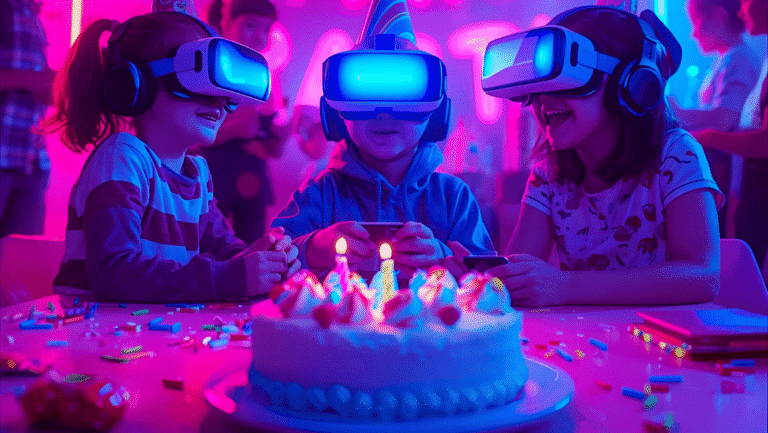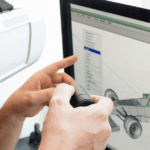Virtual Reality (VR) is a game-changer, changing how we see and interact with virtual worlds. Since Ivan Sutherland introduced it in the 1960s, VR has grown a lot. It now offers immersive experiences that push the limits of our physical world. But how do you use VR to get the most out of it? From gaming to learning, VR opens up many opportunities, using virtual reality techniques to make the impossible possible. It’s more than just wearing a headset; it’s diving into a new world of immersive virtual reality adventures and learning.
Learning the VR technology basics is key to using it well in different fields. VR has many types, from fully immersive to semi-immersive. It uses headsets, screens, tracking, and input devices to connect us with digital worlds. As VR becomes more popular for training, meetings, and marketing, it’s clear VR is here to stay.
VR is changing many areas, like healthcare, teamwork, and gaming. In gaming, the VR user experience is crucial, with gamers wanting more real experiences. As VR gets better and easier to use, we’re entering a new era where virtual and real worlds blend together.
Key Takeaways
- VR has evolved a lot since it started and is now improving many areas, like gaming and education.
- Fully immersive VR experiences offer realistic visuals, audio, and touch feedback.
- Knowing VR technology basics is key to using it fully.
- VR is changing how professionals train, learn, and work together.
- The use of VR in gaming is starting a new era of immersive fun.
- Future VR advancements will make the digital and physical worlds even closer.
Understanding the Basics of VR Technology
Virtual reality (VR) has changed how we see digital worlds. It brings us closer to real experiences. This guide is for both new and experienced users. It covers VR devices, system components, and headset basics.
The Evolution of Virtual Reality Devices
VR devices have come a long way. They started in the mid-1990s and have grown a lot since then. Now, they offer full 360-degree movement and are used by 171 million people worldwide.
The Components of Virtual Reality Systems
VR systems use many advanced parts to create a real experience. VR headsets use special lenses for a 3D effect. They also have cameras and sensors to track movement.
VR motion controllers let users interact with virtual worlds. This makes VR experiences more real and fun.
VR Technology: Immersion and Interaction
VR aims to make users feel like they’re really there. It uses high frame rates and haptic feedback for a better feel. This makes virtual interactions feel real.
Knowing how VR works is key for anyone interested. This guide shows how VR has grown and its future possibilities. VR is changing how we play, learn, and work in the digital world.
How Do You Use VR: A Step-by-Step Guide
Starting your virtual reality journey is exciting. It begins with a vr headset setup guide for a smooth start. Getting started with VR is an adventure, from setup to diving into the virtual world.
Setting Up Your VR Headset: Tips and Instructions
Every vr setup instruction is key for a great VR experience. First, adjust the straps for a comfortable fit. Make sure the headset feels balanced to avoid discomfort.
Next, calibrate the lenses to match your eyes’ distance. This step improves clarity and reduces eye strain. Lastly, install the latest software from trusted sources like the Google Play Store or App Store. This upgrade boosts your device’s performance.
Navigating Virtual Reality: Interaction Methods and Controls
The heart of virtual reality usage is how you interact with it. You start with head movements, thanks to gyroscopic sensors. For more complex actions, use hand controllers and gestures.
It’s important to practice these controls. VR worlds are designed to be easy to use. You can pick up, move, or change objects with simple gestures.
Maximizing User Experience: VR Best Practices
- Lighting: Balance your environment’s lighting to avoid glare on the headset sensors. This helps keep your experience smooth.
- Safety: Make sure your space is clear to avoid accidents. It’s important to stay aware of your surroundings, even when in VR.
- Health: Start with short sessions, about 10 minutes, to avoid cyber sickness. As you get used to VR, you can gradually spend more time.
- Audio: Use headphones for a more immersive experience. They enhance the sound, making your virtual journey feel more real.
Following these vr user tips makes your VR experience better and safer. It ensures you enjoy every virtual adventure. By setting up your VR system right and following these guidelines, you’re ready to explore endless virtual worlds.
The Different Realms of VR: Gaming, Education, and Beyond
Virtual reality (VR) is growing fast and now goes beyond vr gaming experiences. It’s used in education, healthcare, and corporate training. This changes how we learn and work with new, interactive ways.
VR applications in education change how students learn. They can go on virtual field trips and do hands-on simulations. This helps them understand complex subjects better and stay engaged.
VR also helps in professional training and healthcare. Doctors use it for practice and therapy, making it safer and more effective. In business, vr applications overview shows it helps teams work together better and trains people safely and cheaply.
But VR has its challenges, like being expensive and worrying about health effects. Yet, as VR gets better and more people can use it, these problems will lessen. This will help VR grow in many areas.
| Industry | Application | Impact |
|---|---|---|
| Gaming | Oculus Rift, HTC Vive Usage | Enhanced immersive experiences |
| Education | Virtual Field Trips, Simulations | Improved engagement & retention |
| Healthcare | Surgical Training, Therapy | Increased safety and efficiency |
| Corporate | Training, Remote Collaboration | Cost-effective training models |
As VR keeps getting better, it will change many areas. It will make vr gaming experiences better and change how we learn and work in many fields.
VR Applications in Education: The Future of Learning
Virtual reality (VR) is changing education. It’s not just a dream for the future. It’s a real tool that’s making learning better and more fun.
Virtual Reality as an Educational Tool: Case Studies
VR is making a big difference in schools in the U.S. At American University, teachers use VR to help students learn hard subjects. They see big improvements in how well students learn and remember.
Benefits of VR in Student Engagement and Retention
VR grabs students’ attention. For example, using VR in biology classes has led to better grades. It makes learning fun and interactive, helping students remember more.
Creating Immersive Educational Content for VR
Good VR content is key. Tools like CoSpaces Edu and A-Frame help teachers make VR lessons that fit their needs. This way, all students can learn well, no matter their background or ability.
VR is changing education in big ways. It gives teachers new tools to make learning exciting and effective. As VR gets better and more people can use it, it will play an even bigger role in education.
Boosting the Gaming Experience with VR
Virtual Reality (VR) is changing the gaming world. It’s not just about new games; it’s about how we play them. VR offers immersive vr gaming experiences and vr content creation tips that make games better.
VR lets players interact with games in new ways. It’s more natural than old gaming methods. Now, we have multiplayer VR for playing with others in a virtual world.
VR Gaming Experiences: What Sets Them Apart
VR games pull you into a world that feels real. They use amazing graphics, 3D sound, and interactive scenes. This makes VR games more exciting and emotional than regular games.
Designing Games for VR: Content Creation Tips
Making great VR content needs tech and storytelling skills. Good vr content creation tips include using spatial audio and designing easy navigation. It’s also key to make sure everything feels real and works well.
The Social Aspect of VR Gaming: Multiplayer and Community
The gaming community in VR is growing fast. It’s not just for playing games; it’s for making friends. Multiplayer VR games let us work together or compete. This has created a strong, interactive community.
VR combines advanced tech, creative design, and community building. It’s changing digital entertainment. As VR gets better, it will offer even more amazing gaming experiences, shaping the future of gaming.
Virtual Reality in Professional Training: A Game Changer
VR in professional development is changing many industries. It makes training faster and better. It also makes learning more real and interactive.
VR Simulators in Industry: From Healthcare to Aviation
Healthcare and aviation are using vr simulator technology. It lets professionals train in safe, real-like settings. For example, doctors can practice surgeries without risk. Pilots can learn to fly in a safe, virtual cockpit.
The Role of VR in Safety and Skill Acquisition
VR training is great for safety and learning new skills. It lets people practice without risk. Studies show VR makes learning more emotional and effective.
Constructing Effective Training Programs Using VR Technology
Creating good vr training needs to know what skills are needed. A good VR program uses real-life scenarios. It’s also important to have VR that can be changed for different needs.
For example, VR can teach people about complex machinery without damaging it. It can also help retail workers practice customer service in a virtual store.
VR training can be done from anywhere, saving money on travel and equipment. It also helps train a global workforce. Even though VR training costs money at first, it saves money in the long run.
| Benefit | Impact |
|---|---|
| Cost Efficiency | Reduces traditional training costs, like travel and physical materials |
| Emotional Connection | Improves learner engagement and knowledge retention |
| Safety in Training | Enables risk-free repetition of critical tasks in a simulated environment |
| Accessibility | Provides remote training options for geographically dispersed employees |
| Customization | Allows creation of industry-specific training modules |
In conclusion, VR in professional training is a big change. It helps develop important skills and changes how we train. It promises a future where learning is efficient, engaging, and safe.
Exploring the Spectrum: AR, MR and the Future of VR
Digital simulation technologies like AR, MR, and VR are changing how we see the world. By looking at ar vs vr, we learn about their different uses and how they can work together. AR adds digital info to the real world, VR takes us into virtual spaces, and MR mixes both.
Mixed reality, or mixed reality technology, is where real and digital things meet. It uses advanced tech to make these interactions smooth. This opens up new ways for immersive VR experiences that are limited only by our imagination.
The virtual reality future will change how we see our world. It will bring new ideas to education, healthcare, manufacturing, and entertainment. These areas will see big changes in how we interact and see data.
| Technology | Introduction Year | Key Feature | Primary Devices |
|---|---|---|---|
| Virtual Reality (VR) | 1994 | Full immersion in a virtual environment | Oculus Rift, HTC Vive, PSVR |
| Augmented Reality (AR) | 1968 | Overlays digital information onto the real world | Smartphones, Hololens, Magic Leap |
| Mixed Reality (MR) | Use term since 1994 | Combines elements of both AR and VR | Windows Mixed Reality, Magic Leap |
Looking ahead, these technologies might come together in something called ‘the metaverse’. Knowing the differences between ar vs vr and MR is key. This knowledge will help developers and users use these technologies fully, leading to a merged reality.
Designing Intuitive VR Content: Best Practices and Techniques
Creating great VR content starts with knowing how users experience it. Whether it’s games, educational tools, or training simulations, the goal is to make users feel like they’re really there. This means creating a believable and engaging virtual world.
Understanding the VR User Experience: What Makes Content Compelling
In VR, visuals, sounds, and movements must work together perfectly. This creates a world where users feel like they’re part of it. To make VR experiences better, focus on stories that move, detailed settings, and easy-to-use controls. This makes interactions smooth and meaningful.
Details like sound, touch, and depth are key. Good sound quality, for example, makes the experience feel more real. Also, making sure the VR is comfortable is important. This helps users stay engaged without feeling sick or disoriented.
Tools and Software for Creating VR Experiences
The tools you choose are very important for making VR content. From simple sketches to advanced software like Unity or Unreal Engine, there’s a lot to choose from. These tools help create detailed and realistic environments.
There are also special tools like Mozilla A-Frame and Daydream VR for different needs. They help designers at every step of their work.
Expert Advice on Crafting Immersive VR Narratives
Good VR stories keep users interested. Experts say it’s important to let users shape the story. This means the story can change based on what the user does.
Interactions should feel natural and rewarding. Things like how gestures work should match how we naturally interact. This makes the virtual world easy to explore.
In the world of VR, it’s important to keep up with new tools and techniques. By focusing on these, creators can make experiences that are not just impressive but also deeply engaging.
Ensuring Accessibility in Virtual Reality
Virtual reality (VR) can change the world when it’s for everyone. As VR gets better, adding vr accessibility features is key. This makes VR great for learning, empathy, and fun for all.
Creating a VR world that’s for everyone means thinking about cognitive considerations in VR and physical needs. This way, VR is more than tech; it’s a place where everyone feels welcome.
Making VR Experiences Inclusive for All Users
Vr inclusive design focuses on different abilities. It offers many ways to interact, like voice commands and hand tracking. Text-to-speech and speech recognition make it easy for everyone to use VR.
Considering Physical and Cognitive Needs in VR Design
VR apps need customizable settings for different users. Things like font size and color contrast help those with visual issues. For hearing challenges, visual alerts and captions are key. These features make VR fun and usable for everyone.
Accessibility Features in Leading VR Technology
Top VR platforms now have built-in accessibility features. Haptic feedback and spatial audio are big improvements. They help users with visual and hearing impairments enjoy VR more.
For more on VR accessibility, check out this guide on making VR inclusive for all.
Adapting VR for Business: Corporate Uses of Virtual Reality
The virtual reality market is growing fast. It’s changing how businesses work. This change is because of better training, teamwork, and customer service. Let’s see how VR for business is changing different industries.
VR technology makes training 75-90% better. Companies like Walmart and McDonald’s are using it. They see better employee skills and customer service thanks to VR from STRIVR and Tantrum Labs.
VR also helps with teamwork and showing products. Apple’s Vision Pro headset shows how VR can change how we work together. It makes virtual reality in the workplace very useful.
VirtualSpeech mixes online classes with VR. It improves communication and business skills in real settings. This shows a mix of old and new learning methods.
Vantage Point uses VR for sensitive training. It teaches about sexual harassment and bystander intervention. This tech boosts empathy and cuts down on workplace problems.
In healthcare, Johnson & Johnson Institute and Osso VR have seen a 230% boost in surgery skills. This is thanks to VR training.
- The defense sector uses VR for better training, like the Virtual Squad Training System in Hawaii.
- VR in education lets learners train four times faster than in class.
- VR in retail boosts product demos by 94%.
These examples show VR technology in business is versatile. It improves work efficiency and prepares workers better.
The global VR market is expected to grow to $244.84 billion by 2032. Young consumers prefer brands that use VR/AR. This shows VR’s big future in business.
In conclusion, businesses are using VR technology to stand out. They’re creating a more innovative, efficient, and connected work world.
Conclusion
Virtual reality is changing how we interact and experience things in many areas. With vr technology insights, VR has become more than just for games. It’s now used in education, healthcare, and business too.
VR has made big improvements in learning, aviation, military, and manufacturing. It shows VR’s endless possibilities and growth.
VR’s future looks bright. More people will use VR devices, from 2.5 million in 2016 to 24 million by 2018. This shows we’re ready to use VR more.
Creating easy-to-use VR content is key. Examples like Kokowa’s 3D spaces and Otago University’s virtual hospital show VR’s progress. They help us learn and solve problems in safe, real-like settings.
But we need to use VR wisely. The tech world needs rules to keep VR safe and healthy. High internet addiction rates remind us to use VR carefully.
Exploring virtual worlds is exciting but also comes with big responsibilities. We must find a balance for VR to fit well in our digital lives.


















